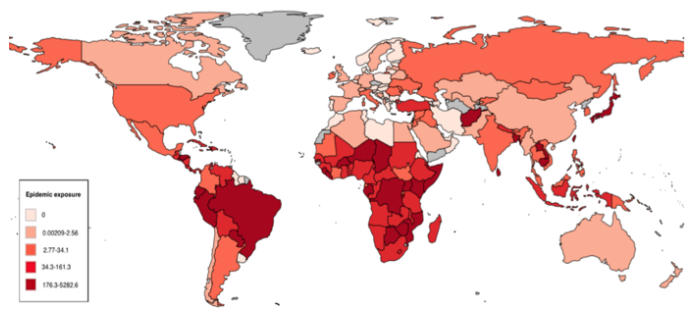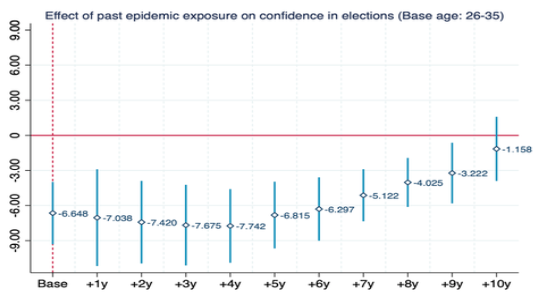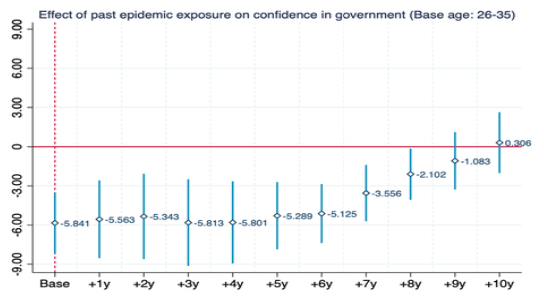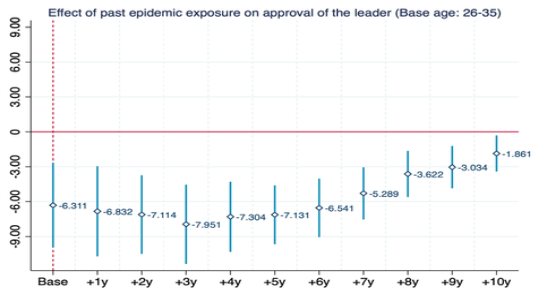Cevat Giray Aksoy, Barry Eichengreen, Orkun Saka
What will be the political legacy of the COVID-19 pandemic? This column uses data from the 2006-2018 Gallup World Polls to show that epidemic exposure during an individual’s ‘impressionable years’ of 18 to 25 has a persistent negative effect on trust in political institutions and leaders, especially in democracies. Combined with other evidence that trust is important for limiting the spread of infection, this raises the spectre of a circular, self-reinforcing spiral in which poor public health policy leads to deeper distrust, further undermining the effectiveness of public health policy.
It is widely argued (e.g. Fukyuama 2020) that the keys to success in dealing with COVID-19 are “whether citizens trust their leaders, and whether those leaders preside over a competent and effective state.” By way of example, Rothstein (2020) ascribes the greater success at containing the COVID-19 in the Nordic countries than in Italy in part to greater trust in government.
Trust in government is not a given, however (Dustmann et al. 2017, Grosjean 2019). Specifically, there is reason to ask whether COVID-19 itself will affect trust in political institutions and leaders.
New evidence
In a new paper, we provide the first evidence on the effects of epidemics on political trust (Aksoy et al. 2020). We use individual-level data on confidence in political institutions and leaders from the 2006-2018 Gallup World Polls (GWP), fielded in nearly 140 countries annually. Our data cover some 750,000 respondents from 142 countries. We analyse responses to questions about confidence in the government, confidence in elections, and approval of national leaders. We link these individual responses to the incidence of epidemics since 1970 as tabulated in the EM-DAT International Disasters Database (see Figure 1). By incorporating a wide range of fixed effects, controlling various observable characteristics as well as past exposure to other economic and political shocks, we can address potential concerns with omitted variables.
Figure 1 Average number of people (per million) affected by epidemics, 1970-2017

Notes: This figure shows the number of people affected by epidemics (per million), averaged across all available years.
Source: EM-DAT International Disaster Database, 1970-2017, UN Population Database, 1970-2017, and authors’ calculations.
Building on previous work suggesting that attitudes and behaviour are durably moulded in what psychologists and sociologists refer to as the ‘impressionable’ late-adolescent and early-adult years, we show that exposure to epidemics at this stage in the life course durably shapes confidence in political institutions and attitudes toward political leaders. (On the ‘impressionable years’, hypothesis, see Dawson and Prewitt 1969 and Krosnick and Alwin 1989; for an economic application, see Guiliano and Spilimbergo 2014.)
Specifically, we find that individuals who experience epidemics in their impressionable years (specifically, ages 18 to 25) display less confidence in political leaders, governments, and elections. The effects are substantial: an individual with the highest exposure to an epidemic (relative to zero exposure) is 7.2 percentage points less likely to have confidence in the honesty of elections; 5.1 percentage points less likely to have confidence in the national government; and 6.2 percentage points less likely to approve the performance of the political leader. (The respective averages of these three variables in our sample are 51%, 50%, and 50%.) These effects represent the average treatment values for the remainder of life. They decay only gradually and persist for two decades: the difference between the median age during impressionable years (21.5) and the median age in the last subsample (40.5) corresponds to 19 years (Figure 2).
Figure 2 Effects of epidemics in impressionable years over subsamples with rolling age-windows



Note: This figure shows the persistence of the effects on three main outcome variables by restricting the observations to the respondents who are in the 26-35 age range at the time of the survey (Base sample) and then repeatedly rolling this age window forward by one year for each separate estimation. The plotted coefficient is Exposure to epidemic (18-25) in Equation (1) in Aksoy et al. (2000). Confidence intervals are at 95% significance level.
Source: Gallup World Polls, 2006-2018 and EM-DAT International Disaster Database, 1970-2017.
There is significant heterogeneity in these effects. Less-educated individuals respond more strongly, adopting even more negative attitudes towards political institutions and leaders. Residents of urban areas respond more negatively than those residing in rural areas. Women display larger drops in confidence. The negative impact of epidemic exposure is larger in middle- and high-income countries.
Amplification and transmission
We then explore amplification and transmission mechanisms. We show that the effects we identify are specific to communicable diseases, such as viruses, which can spread contagiously and where a timely and effective public policy response is critical for containment. For non-communicable diseases, in contrast, we do not see the same impact of past impressionable-year outbreaks on subsequent views of the trustworthiness of governments and leaders.
In addition, individuals exposed to epidemics in their impressionable years are less likely to have confidence in the public health system and the safety and efficacy of vaccination. The former is indicative of trust in the overall health policies of the government, while the latter can be taken as reflecting attitudes specifically toward pharmaceutical interventions. These findings suggest that the perceived (in)adequacy of health-related government interventions during epidemics, both pharmaceutical and non-pharmaceutical, are important for trust in government more generally.
Government strength matters
In addition, the magnitude of the effect we identify depends on the strength of the government at the time of the epidemic. When individuals experience epidemics under weak governments, the negative impact on trust is larger and more persistent. This is consistent with the idea that such governments are less capable of effectively responding to epidemics, hence leading to a long-term fall in political trust.
We substantiate this conjecture by considering this same conditioning factor, government strength, in the context of COVID-19. We show that government strength is associated with statistically significant improvements in policy response time (the number of days between the date of first confirmed case and the date of the first non-pharmaceutical intervention). This supports the notion that government strength at the time of the epidemic is a predictor of effective policy responses and that its absence amplifies the negative revision of political trust in response to epidemics.
Finally, we show that our results are driven by the reaction to epidemic exposure in democracies. In democracies, residents sharply and persistently revise (downward) their political trust in the event of impressionable-year epidemic exposure. The same is not true in autocracies. Evidently, citizens expect democratic governments to be responsive to their health concerns, and where the public-sector response is not sufficient to head off the epidemic, they revise their views in unfavourable ways. In autocracies, in contrast, there may not exist a comparable expectation of responsiveness and hence no impact on political trust. In addition, democratic regimes may find consistent messaging more difficult. Because such regimes are open, they may allow for a cacophony of conflicting official views, resulting in a larger impact on trust when things go wrong.
Conclusion
Trust and confidence in government are important for the capacity of a society to organise an effective collective response to an epidemic. Yet there is also the possibility that experiencing an epidemic can negatively affect an individual’s confidence in political institutions and trust in political leaders, with negative implications for this collective capacity. We have shown that this negative effect is large and persistent. Its largest and most enduring impact is on the attitudes of individuals who are in their impressionable late-adolescent and early-adult years when an epidemic breaks out.
In addition, epidemic exposure in one’s impressionable years matters mainly for residents of democratic countries. Residents in democracies sharply revise downward their confidence and trust in political institutions and leaders following significant exposure, whereas the same is not true in autocracies. It may be that citizens expect democratic governments to be responsive to their concerns and that where the public-sector response is not adequate, they revise their attitudes unfavourably. In autocracies, there may not exist a comparable expectation of responsiveness. In addition, democratic regimes may find consistent messaging more difficult. Because such regimes are open, they may allow for a cacophony of conflicting official views, resulting in a larger impact on confidence and trust.
The implications are disturbing. Imagine that more trust in government is important for effective containment, but that failure of containment harms trust in government.1 One can envisage a scenario where low levels of trust allow an epidemic to spread, and where the spread of the epidemic reduces trust in government still further, hindering the ability of the authorities to contain future epidemics and address other social problems. As Schmitt (2020) puts it, “lack of trust in government can be a circular, self-reinforcing phenomenon: Poor performance leads to deeper distrust, in turn leaving government in the hands of those with the least respect for it.”
No comments:
Post a Comment